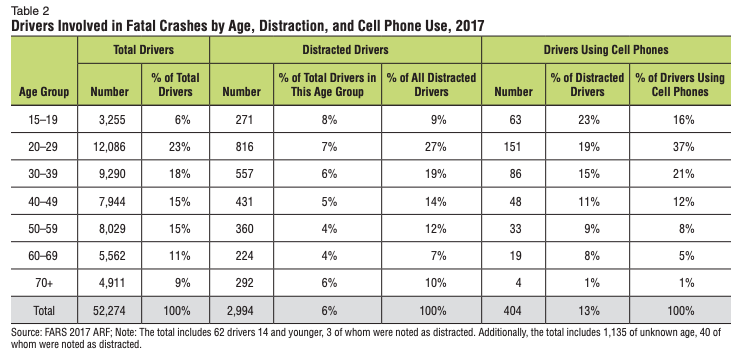Your teen may be twice as likely as you to get into an accident as a result of distracted driving, but that doesn’t mean you’re not part of the problem.
People are driving more miles than ever before, and adults are driving while distracted and their kids are watching. The next time you reach for that cell phone or decide to fix your hair at a stoplight, know that your actions are directly affecting the type of driver your kid will become.
What Is Considered Distracted Driving?
Anything that takes your concentration off the road is distracted driving. The National Safety Council breaks down distracted driving into three categories:
- Visual distractions: Anytime you take your eyes off the road
- Manual distractions: Anytime you take your hands off the wheel
- Cognitive distractions: Anytime you let your mind wander away from focusing on driving
Distracted driving has become such a problem that it’s considered an epidemic in the United States. While everyone points the fingers at teens, unfortunately it’s adults who teens are getting their bad habits from.
If you need some more convincing, here are just a few stats that may open your eyes to the problem.
- Each day, approximately 9 people are killed and more than 1,000 injured as a result of distracted driving.
- At 55 mph, sending or reading a text takes your eyes off the road for 5 seconds. That’s enough time to drive across a football field.
- 77% of adults and 55% of teens believe they can easily manage texting while driving.
- Texting while driving increases the chances of an accident by 23%.
Who is Driving Distracted?
Every year, more than 3,000 people die in crashes as a result of distracted driving. No one is unsusceptible to distracted driving, and it may even come as a surprise that young teens don’t make up the majority of distracted drivers behind the wheel while drivers aged 20 to 29 do.
Source: https://crashstats.nhtsa.dot.gov/Api/Public/ViewPublication/812700
While teens may not be the most distracted on the road, they are still the highest at risk to be in an accident, and watching your own behavior behind the wheel and in the home can shape the driver your teen is.
What Is Distracting People While Driving?
There are countless things that are distracting people behind the wheel. We hear mostly of cell phone use, but there’s a long list of other distractions:
- Adjusting the radio or temperature
- Other passengers in the vehicle
- Looking for things inside or outside your car
- Putting out a cigarette
- Being lost in thought
- Snacking or eating
- Listening to music
- Having to use the restroom
- Cell phone usage
- Applying makeup
- Driving with kids
- Having your dog in the car
- Advanced technology in cars
In addition to these distractions, teens also have to deal with you, their parent, being a large distraction. Recent studies show that 50% of teen drivers said they spoke with a parent while driving and 18% said they texted their parents. Even more, parents are calling teens when they know they’re driving and expecting them to answer.
While there are plenty of ways to get distracted while driving, a majority of people believe they’re capable of handling the distractions. In recent studies, more than 80% of drivers admitted to performing obviously dangerous acts while driving, such as applying makeup, eating, or even shaving. This comes as no surprise that 80% of accidents are attributed to distracted driving.
The next time you take a drive, try and pay attention to all the times that you’re distracted by something that could have been prevented.
Why Are Drivers Distracted behind the Wheel?
Believe it or not, there’s science behind why drivers are so easily distracted behind the wheel.
- Cell phones are addictive: By nature we’re addicted to technology and our cell phones. People want to be “connected” at all times. Twenty-eight percent of drivers say that they’re afraid of missing something important while driving.
- We’re used to immediately responding: When we hear the ding of a text message or alert, we instinctively respond. This is causing more and more people to take their eyes off the road.
- We get a good feeling when we get a cell phone alert: Receiving a text, email, or social media alert results in an increase in dopamine to the brain. Essentially, it makes us feel really good and therefore results in people reaching for their phones, no matter the consequences.
- We get away with being distracted: Every time we successfully survive being distracted behind the wheel, we’re more likely to believe that we’re capable of multitasking without negative effects.
Tips for Becoming Hands-Free while Driving
Distracted driving is the top cause of teen accidents, and there are a variety of ways that you as a parent can help combat that epidemic. The truth is you have to set a good example for your teen long before they’re preparing to drive.
By working to become hands-free yourself, you’re setting a good example for your child from the beginning of their life.
- Understand the penalties
Nearly every state has a fine for distracted driving. The amount varies depending on the state you’re in, but it can range anywhere from $25 to $500+ and jail time. In addition, 47 states now have laws prohibiting or restricting texting while driving and 38 states have banned cell phone use while driving.
| State | Fines | Hand-held Ban | Texting Restrictions/Ban |
| Alabama | Yes | No | Yes |
| Alaska | Yes | Yes | Yes |
| Arizona | Yes | Yes | Yes |
| Arkansas | Yes | Yes (Limited*) | Yes |
| California | Yes | Yes | Yes |
| Colorado | Yes | No | Yes |
| Connecticut | Yes | Yes | Yes |
| Delaware | Yes | Yes | Yes |
| Florida | Yes | No | Yes |
| Georgia | Yes | Yes | Yes |
| Hawaii | Yes | Yes | Yes |
| Idaho | Yes | No | Yes |
| Illinois | Yes | Yes | Yes |
| Indiana | Yes | No | Yes |
| Iowa | Yes | No | Yes |
| Kansas | Yes | No | Yes |
| Kentucky | Yes | No | Yes |
| Louisiana | Yes | No | Yes |
| Maine | Yes | Yes | Yes |
| Maryland | Yes | Yes | Yes |
| Massachusetts | Yes | Local Option | Yes |
| Michigan | Yes | Local Option | Yes |
| Minnesota | Yes | No | Yes |
| Mississippi | Yes | No | Yes |
| Missouri | Yes | No | 21 and younger |
| Montana | No | No | No |
| Nebraska | Yes | No | Yes |
| Nevada | Yes | Yes | Yes |
| New Hampshire | Yes | Yes | Yes |
| New Jersey | Yes | Yes | Yes |
| New Mexico | Yes | Local Option | Yes |
| New York | Yes | Yes | Yes |
| North Carolina | Yes | No | Yes |
| North Dakota | Yes | No | Yes |
| Ohio | Yes | Local Option | Yes |
| Oklahoma | Yes | Yes (Limited*) | Yes |
| Oregon | Yes | Yes | Yes |
| Pennsylvania | Yes | Local Option | Yes |
| Rhode Island | Yes | Yes | Yes |
| South Carolina | Yes | No | Yes |
| South Dakota | Yes | No | Yes |
| Tennessee | Yes | Yes | Yes |
| Texas | Yes | Yes (Limited*) | Yes |
| Utah | Yes | Yes (Limited*) | Yes |
| Vermont | Yes | Yes | Yes |
| Virginia | Yes | No | Yes |
| Washington | Yes | Yes | Yes |
| West Virginia | Yes | Yes | Yes |
| Wisconsin | Yes | No | Yes |
| Wyoming | Yes | No | Yes |
*limited means restricted to certain driving zones. *local option means varies by city
Be a smart driver
Limit your multitasking while in the car. Being conscious of potential distractions and working hard to not pursue them will put you in the habit of focusing on your driving. Don’t take on the “it could never happen to me” attitude.
Set your phone to “Do Not Disturb” while driving
Many cell phones now offer the ability to have your phone automatically go to “Do Not Disturb” while driving. If you have this feature, turn it on, and if you don’t, try and manually put your phone on Do Not Disturb when you get in the car.
Add a Bluetooth to your vehicle
If you absolutely can’t ignore your phone while in the car, add a Bluetooth to your vehicle if it doesn’t come with one already.
Help Fight against Distracted Driving
Distracted driving is a major issue for drivers of all ages. Technology and busy lives make time in a car feel like precious minutes we’re unable to do other things.
While it can be difficult to not multitask while operating a vehicle, keep in mind who else in your car is watching your driving habits, a.k.a. your kids. Kids are always watching, inside and outside the vehicle. It’s your responsibility to show children what a safe driver is, so they can be safe drivers themselves when it’s their time to get on the road.
Sources © 2020, Consumer Agent Portal, LLC. All rights reserved.
http://www.ncsl.org/research/transportation/cellular-phone-use-and-texting-while-driving-laws.aspx
https://teensafe.com/100-distracted-driving-facts-statistics-for-2018/
https://crashstats.nhtsa.dot.gov/Api/Public/ViewPublication/812700
https://www.nhtsa.gov/risky-driving/distracted-driving




Leave a Reply